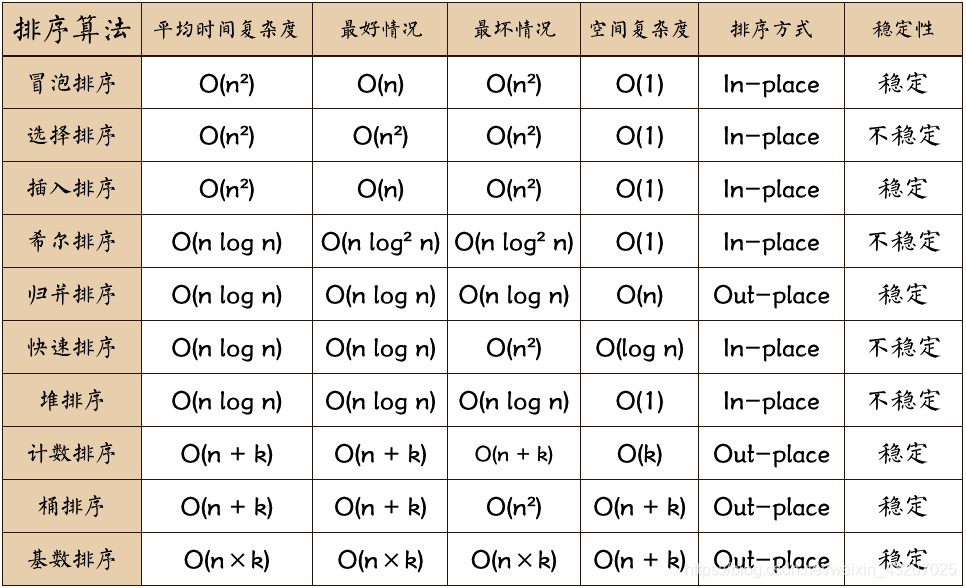【掌握排序算法的奥秘】:揭秘十大常见算法的实现与优化秘籍
发布时间: 2024-08-24 11:57:23 阅读量: 8 订阅数: 12 


# 1. 排序算法的基础**
排序算法是计算机科学中解决数据排序问题的一类算法。其目标是将一个无序的数据序列重新排列成一个有序序列。排序算法广泛应用于各种领域,例如数据分析、数据库管理和分布式系统。
排序算法的分类有很多种,其中最常见的分类是基于比较和非比较算法。比较算法通过比较元素之间的值来确定元素的顺序,而非比较算法则通过其他方式(例如计数或哈希)来确定元素的顺序。
# 2. 排序算法的实现
### 2.1 冒泡排序
#### 2.1.1 算法原理
冒泡排序是一种简单的排序算法,它通过不断比较相邻元素并交换位置,将较大的元素“冒泡”到数组的末尾。算法从数组的开头开始,逐个比较相邻元素,如果前一个元素大于后一个元素,则交换它们的顺序。然后,算法再次从数组的开头开始重复这一过程,直到没有元素需要交换为止。
```python
def bubble_sort(arr):
"""
冒泡排序算法
参数:
arr: 待排序的数组
返回:
排序后的数组
"""
n = len(arr)
for i in range(n):
for j in range(0, n - i - 1):
if arr[j] > arr[j + 1]:
arr[j], arr[j + 1] = arr[j + 1], arr[j]
return arr
```
#### 2.1.2 优化技巧
* **优化 1:标记已排序元素**
在每次遍历中,如果没有任何元素被交换,则说明数组已经排序完毕,可以提前终止算法。
```python
def bubble_sort_optimized(arr):
"""
优化后的冒泡排序算法
参数:
arr: 待排序的数组
返回:
排序后的数组
"""
n = len(arr)
for i in range(n):
swapped = False
for j in range(0, n - i - 1):
if arr[j] > arr[j + 1]:
arr[j], arr[j + 1] = arr[j + 1], arr[j]
swapped = True
if not swapped:
break
return arr
```
### 2.2 快速排序
#### 2.2.1 算法原理
快速排序是一种分治排序算法,它通过选择一个枢纽元素,将数组划分为两个子数组,然后递归地对这两个子数组进行排序。枢纽元素通常选择为数组的第一个或最后一个元素。
```python
def quick_sort(arr):
"""
快速排序算法
参数:
arr: 待排序的数组
返回:
排序后的数组
"""
if len(arr) <= 1:
return arr
pivot = arr[0]
left = [x for x in arr[1:] if x < pivot]
right = [x for x in arr[1:] if x >= pivot]
return quick_sort(left) + [pivot] + quick_sort(right)
```
#### 2.2.2 优化技巧
* **优化 1:随机选择枢纽元素**
随机选择枢纽元素可以避免最坏情况下的时间复杂度 O(n^2)。
```python
def quick_sort_optimized(arr):
"""
优化后的快速排序算法
参数:
arr: 待排序的数组
返回:
排序后的数组
"""
if len(arr) <= 1:
return arr
import random
pivot = arr[random.randint(0, len(arr) - 1)]
left = [x for x in arr[1:] if x < pivot]
right = [x for x in arr[1:] if x >= pivot]
return quick_sort_optimized(left) + [pivot] + quick_sort_optimized(right)
```
### 2.3 归并排序
#### 2.3.1 算法原理
归并排序是一种分治排序算法,它通过将数组递归地分成较小的子数组,对这些子数组进行排序,然后将排序后的子数组合并在一起。
```python
def merge_sort(arr):
"""
归并排序算法
参数:
arr: 待排序的数组
返回:
排序后的数组
"""
if len(arr) <= 1:
return arr
mid = len(arr) // 2
left = merge_sort(arr[:mid])
right = merge_sort(arr[mid:])
return merge(left, right)
def merge(left, right):
"""
合并两个排序好的数组
参数:
left: 左边排序好的数组
right: 右边排序好的数组
返回:
合并后的排序数组
"""
i = 0
j = 0
merged = []
while i < len(left) and j < len(right):
if left[i] < right[j]:
merged.append(left[i])
i += 1
else:
merged.append(right[j])
j += 1
while i < len(left):
merged.append(left[i])
i += 1
while j < len(right):
merged.append(right[j])
j += 1
return merged
```
#### 2.3.2 优化技巧
* **优化 1:使用哨兵元素**
使用哨兵元素可以简化合并过程,避免额外的比较。
```python
def merge_sort_optimized(arr):
"""
优化后的归并排序算法
参数:
arr: 待排序的数组
返回:
排序后的数组
"""
if len(arr) <= 1:
return arr
mid = len(arr) // 2
left = merge_sort_optimized(arr[:mid])
right = merge_sort_optimized(arr[mid:])
return merge_optimized(left, right)
def merge_optimized(left, right):
"""
优化后的合并函数
参数:
left: 左边排序好的数组
right: 右边排序好的数组
返回:
合并后的排序数组
"""
merged = []
left.append(float('inf'))
right.append(float('inf'))
i = 0
j = 0
while i < len(left) and j < len(right):
if left[i] < right[j]:
merged.append(left[i])
i += 1
else:
merged.append(right[j])
j += 1
return merged
```
# 3. 排序算法的比较与选择
### 3.1 不同算法的时间复杂度分析
时间复杂度是衡量算法效率的重要指标,它表示算法执行所需的时间。对于排序算法,时间复杂度通常取决于待排序元素的数量 n。
| 算法 | 最好情况 | 最坏情况 | 平均情况 |
|---|---|---|---|
| 冒泡排序 | O(n) | O(n²) | O(n²) |
| 快速排序 | O(n log n) | O(n²) | O(n log n) |
| 归并排序 | O(n log n) | O(n log n) | O(n log n) |
| 插入排序 | O(n) | O(n²) | O(n²) |
| 希尔排序 | O(n) | O(n²) | O(n log n) |
| 归并插入排序 | O(n) | O(n²) | O(n log n) |
| 三向切分快速排序 | O(n log n) | O(n²) | O(n log n) |
| 非递归快速排序 | O(n log n) | O(n²) | O(n log n) |
从表中可以看出,归并排序和快速排序在大多数情况下具有较好的时间复杂度,为 O(n log n)。而冒泡排序和插入排序的时间复杂度较差,为 O(n²)。
### 3.2 不同算法的空间复杂度分析
空间复杂度表示算法执行所需的内存空间。对于排序算法,空间复杂度通常取决于待排序元素的数量 n 和所使用的辅助空间。
| 算法 | 空间复杂度 |
|---|---|
| 冒泡排序 | O(1) |
| 快速排序 | O(log n) |
| 归并排序 | O(n) |
| 插入排序 | O(1) |
| 希尔排序 | O(1) |
| 归并插入排序 | O(n) |
| 三向切分快速排序 | O(log n) |
| 非递归快速排序 | O(log n) |
从表中可以看出,冒泡排序和插入排序的空间复杂度较低,为 O(1)。而归并排序和归并插入排序的空间复杂度较高,为 O(n)。
### 3.3 不同算法的稳定性分析
稳定性是指算法在排序相同元素时,保持其相对顺序不变。
| 算法 | 稳定性 |
|---|---|
| 冒泡排序 | 稳定 |
| 快速排序 | 不稳定 |
| 归并排序 | 稳定 |
| 插入排序 | 稳定 |
| 希尔排序 | 不稳定 |
| 归并插入排序 | 稳定 |
| 三向切分快速排序 | 不稳定 |
| 非递归快速排序 | 不稳定 |
从表中可以看出,冒泡排序、归并排序和归并插入排序是稳定的算法。而快速排序、希尔排序和三向切分快速排序是不稳定的算法。
## 算法选择
在选择排序算法时,需要考虑以下因素:
* **数据量:**对于小数据量,冒泡排序和插入排序可以快速排序。对于大数据量,归并排序和快速排序更合适。
* **时间复杂度:**对于需要快速排序的情况,归并排序和快速排序是首选。
* **空间复杂度:**对于空间受限的情况,冒泡排序和插入排序是更好的选择。
* **稳定性:**对于需要保持相对顺序不变的情况,冒泡排序、归并排序和归并插入排序是合适的。
# 4. 排序算法的优化
### 4.1 插入排序的优化
#### 4.1.1 希尔排序
希尔排序是一种基于插入排序的改进算法,它通过将数组中的元素分组,然后对每个组进行插入排序来提高效率。其核心思想是先将数组中的元素按照一定的间隔进行分组,然后对每个组进行插入排序,最后再将各个组合并起来。
**算法原理:**
1. 选择一个间隔 `h`,将数组划分为 `h` 个组。
2. 对每个组进行插入排序。
3. 缩小间隔 `h`,重复步骤 1 和 2,直到 `h` 为 1。
**优化技巧:**
* **间隔序列的选择:**希尔排序的效率取决于间隔序列的选择。常用的间隔序列有:
* 希尔序列:`h = h/3 + 1`
* 西德维克序列:`h = (h + 1)/2`
* **缩小间隔的策略:**缩小间隔的策略也会影响希尔排序的效率。常用的策略有:
* 线性缩小:`h = h - 1`
* 指数缩小:`h = h/2`
#### 4.1.2 归并插入排序
归并插入排序是一种将归并排序和插入排序相结合的算法。它首先将数组划分为较小的子数组,然后对每个子数组进行归并排序。最后,对所有归并后的子数组进行插入排序。
**算法原理:**
1. 将数组划分为较小的子数组。
2. 对每个子数组进行归并排序。
3. 对所有归并后的子数组进行插入排序。
**优化技巧:**
* **子数组大小的选择:**子数组的大小会影响归并插入排序的效率。通常,子数组的大小应为 `O(log n)`。
* **插入排序的优化:**可以采用二分查找等优化技巧来提高插入排序的效率。
### 4.2 快速排序的优化
#### 4.2.1 三向切分快速排序
三向切分快速排序是一种对快速排序的改进,它将数组中的元素划分为三部分:小于基准元素的、等于基准元素的和大于基准元素的。
**算法原理:**
1. 选择一个基准元素。
2. 将数组中的元素划分为三部分:小于基准元素的、等于基准元素的和大于基准元素的。
3. 对小于基准元素的部分和大于基准元素的部分递归应用快速排序。
**优化技巧:**
* **基准元素的选择:**基准元素的选择会影响三向切分快速排序的效率。常用的基准元素选择策略有:
* 中位数选择:选择数组中三个元素的中位数作为基准元素。
* 随机选择:随机选择一个元素作为基准元素。
#### 4.2.2 非递归快速排序
非递归快速排序是一种不需要递归调用的快速排序算法。它使用栈来模拟递归调用,从而避免了递归调用的开销。
**算法原理:**
1. 将基准元素压入栈中。
2. 从栈中弹出基准元素,将数组划分为两部分:小于基准元素的和大于基准元素的。
3. 将小于基准元素的部分和大于基准元素的部分压入栈中。
4. 重复步骤 2 和 3,直到栈为空。
**优化技巧:**
* **栈的实现:**栈的实现会影响非递归快速排序的效率。常用的栈实现有:
* 数组栈
* 链表栈
* **尾递归优化:**如果快速排序的递归调用是尾递归,可以采用尾递归优化技术来提高效率。
# 5.1 数据分析中的排序应用
排序算法在数据分析中扮演着至关重要的角色,它可以帮助分析师从大量数据中提取有意义的见解。
### 1. 数据清洗和准备
排序算法可用于对数据进行清洗和准备,以确保数据质量和一致性。例如,通过对数据进行排序,可以识别重复项、异常值和缺失值。
### 2. 数据聚合和分组
排序算法可用于对数据进行聚合和分组,以发现模式和趋势。例如,可以对销售数据进行排序,以按产品、客户或地区分组,并计算每个组的总和、平均值或其他统计量。
### 3. 数据可视化
排序算法可用于对数据进行排序,以创建可视化图表,例如条形图、直方图和散点图。这些图表可以帮助分析师快速识别数据中的模式和异常情况。
### 4. 数据建模和预测
排序算法可用于对数据进行排序,以创建数据模型和预测未来趋势。例如,可以对历史销售数据进行排序,以识别销售模式和预测未来的销售额。
### 5. 数据挖掘和机器学习
排序算法可用于对数据进行排序,以发现隐藏的模式和关系,并训练机器学习模型。例如,可以对客户数据进行排序,以识别客户细分和预测客户行为。
0
0





